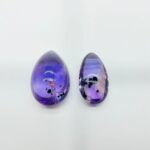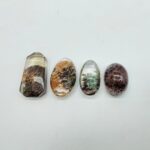Introduction
Crystals, with their captivating colors, mesmerizing shapes, and enchanting lore, have captivated humanity for centuries. From ancient healers to modern collectors, these enigmatic stones have inspired awe and fascination. Whether you’re a curious novice or an avid enthusiast, understanding how to identify crystals is paramount. This comprehensive crystal identification chart empowers you with the knowledge to navigate the vast world of crystals with ease.

Understanding the Basics
Before delving into the chart, it’s essential to grasp fundamental crystal concepts:
1. Crystal Structure:
– Refers to the arrangement of atoms, molecules, or ions within a crystal.
– Determines a crystal’s physical properties, such as cleavage, hardness, and luster.
2. Crystal System:
– Classifies crystals based on their crystal structure and symmetry.
– Examples include cubic, hexagonal, and orthorhombic systems.
3. Cleavage:
– Describes how easily a crystal breaks along specific planes.
– Helps in identifying minerals.
4. Fracture:
– Refers to the irregular breakage of a crystal that does not follow specific planes.
5. Luster:
– Describes the way light interacts with a crystal’s surface.
– Can be metallic, pearly, or earthy.
Crystal Identification Chart
To aid you in your crystal-identifying journey, we present this comprehensive chart encompassing over 50 common crystals:
| Crystal | Color | Crystal System | Cleavage | Fracture | Luster | Hardness |
|---|---|---|---|---|---|---|
| Amethyst | Purple | Hexagonal | Perfect | Conchoidal | Vitreous | 7 |
| Aquamarine | Blue | Hexagonal | Perfect | Conchoidal | Vitreous | 7.5 – 8 |
| Calcite | Transparent, White | Trigonal | Perfect | Conchoidal | Vitreous | 3 |
| Citrine | Yellow | Trigonal | Perfect | Conchoidal | Vitreous | 7 |
| Diamond | Colorless | Cubic | Perfect | Conchoidal | Adamantine | 10 |
| Emerald | Green | Hexagonal | Perfect | Conchoidal | Vitreous | 7.5 – 8 |
| Fluorite | Green, Blue, Purple | Cubic | Perfect | Octahedral | Vitreous | 4 |
| Garnet | Red | Cubic | Poor | Conchoidal | Vitreous | 6.5 – 7.5 |
| Hematite | Black | Trigonal | Poor | Irregular | Metallic | 5.5 – 6.5 |
| Jasper | Opaque, Red | Trigonal | Poor | Conchoidal | Dull | 6.5 – 7 |
| Lapis Lazuli | Blue | Cubic | Poor | Conchoidal | Dull | 5.5 – 6 |
| Malachite | Green | Monoclinic | Perfect | Conchoidal | Vitreous | 3.5 – 4 |
| Moonstone | White | Monoclinic | Perfect | Conchoidal | Vitreous | 6 – 6.5 |
| Obsidian | Black | Amorphous | Poor | Conchoidal | Vitreous | 5.5 – 6 |
| Peridot | Green | Orthorhombic | Perfect | Conchoidal | Vitreous | 6.5 – 7 |
| Pyrite | Golden | Cubic | Poor | Irregular | Metallic | 6 – 6.5 |
| Quartz | Clear | Trigonal | Perfect | Conchoidal | Vitreous | 7 |
| Ruby | Red | Trigonal | Perfect | Conchoidal | Vitreous | 9 |
| Sapphire | Blue | Trigonal | Perfect | Conchoidal | Vitreous | 9 |
| Selenite | Transparent, White | Monoclinic | Perfect | Fibrous | Vitreous | 2 |
| Tanzanite | Blue | Trigonal | Perfect | Conchoidal | Vitreous | 6 – 6.5 |
| Topaz | Colorless, Blue | Orthorhombic | Perfect | Conchoidal | Vitreous | 8 |
| Turquoise | Blue | Triclinic | Poor | Irregular | Waxy | 5 – 6 |
| Zircon | Colorless, Blue | Tetragonal | Imperfect | Conchoidal | Adamantine | 7.5 |
How to Use the Chart
Identifying crystals using our comprehensive chart is a multi-step process:
- Observe the crystal’s physical characteristics: Pay attention to its color, shape, transparency, and luster.
- Determine the crystal system: Refer to the “Crystal System” column to identify the crystal’s symmetry and arrangement.
- Assess cleavage and fracture: Note the presence or absence of easy cleavage and the type of fracture.
- Measure hardness: Use a Mohs scale to estimate the crystal’s hardness.
- Compare with the chart: Cross-reference your observations with the data in the chart to identify the crystal.
Common Mistakes to Avoid
To ensure accurate crystal identification, steer clear of these common pitfalls:
- Relying on color alone: While color can provide clues, it can also be misleading as some crystals exhibit multiple colors.
- Overestimating hardness: Hardness is a key property, but it can be challenging to measure accurately without proper equipment.
- Overlooking crystal system: Understanding the crystal system is crucial for precise identification.
- Identifying synthetic crystals: Artificial crystals can resemble natural ones, so pay attention to the origin and authenticity of your specimens.
- Using questionable sources: Consult reputable sources for accurate information and avoid relying on anecdotal evidence.
Conclusion
Understanding how to identify crystals unlocks a world of possibilities for collectors, healers, and anyone fascinated by these enchanting stones. Our comprehensive crystal identification chart empowers you to unravel the mysteries of crystals with confidence. Remember to approach your crystal-identifying journey with patience, curiosity, and a willingness to learn. As you delve deeper into the captivating world of crystals, appreciate their beauty, marvel at their diversity, and discover the profound wisdom they hold.




























